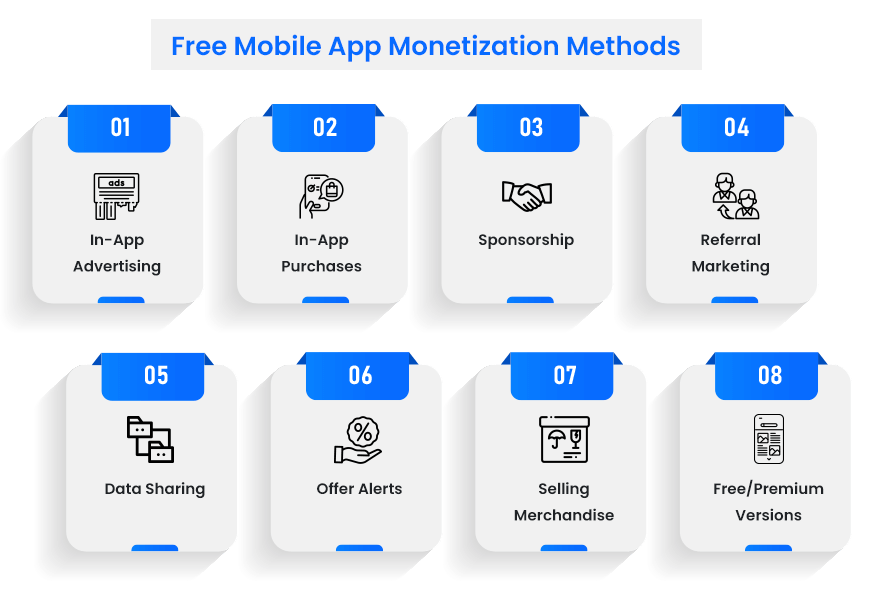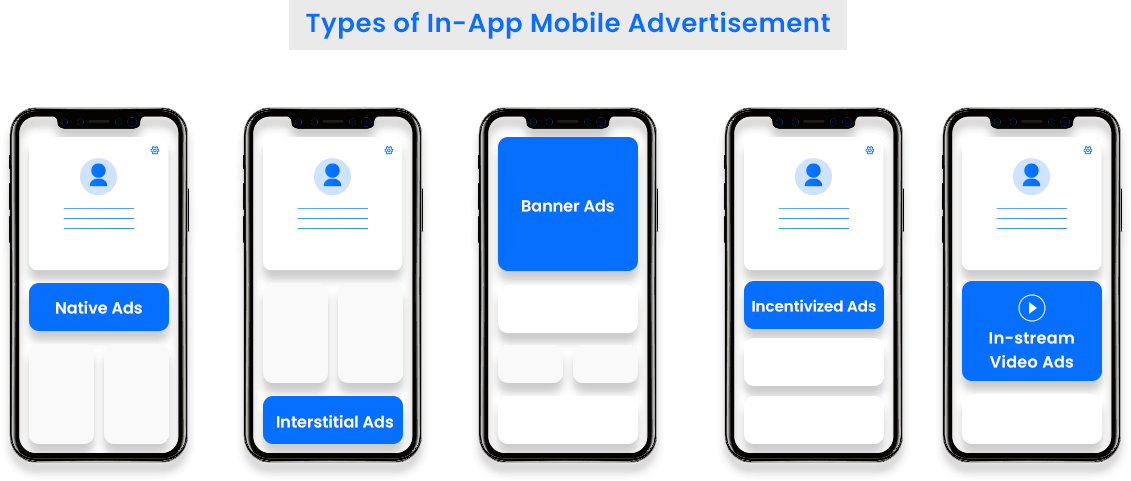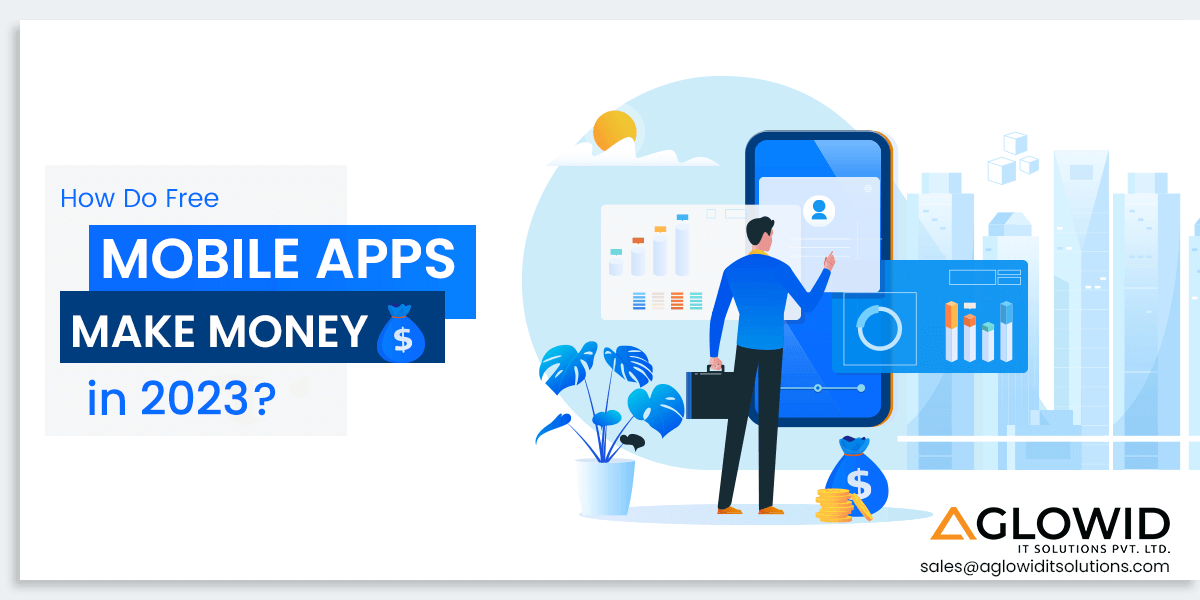There are over 2.87 million apps that are available on the Google Playstore, and Apple’s app store has 1.96 million apps. According to Statista, 92.7 percent of all iOS applications were free, and the Google Play store had 96.7 percent free apps by January 2021. This should help you realize the potential, demand, and impact of free mobile apps on consumers and app selling platforms. But the question remains – how do free mobile apps make money.
While most of you might have a basic answer to this question via in-app purchases or in-app advertisement, many other revenue streams a developer/marketer can choose from. None of the methods is better than the other. There are various paths to reaching the ideal goal of launching a free app and earning making money from it. I would advise you to study all of them in detail and see which is the right fit for your business. Hence, keeping in mind that you already know how to come up with an app idea and have worked on the app development process, you are ready to understand how free mobile apps make money –

1. In-App Advertising
Mobile ads are one of the most common and straightforward ways through which free mobile apps make money. However, many companies make use of this channel in a lazy, abrupt and annoying manner. If you are planning on putting up in-app advertisements for your app, you should always make sure –
- Ad Intrusiveness – Try avoiding ads and timing them in a way that interrupts the user experience for your customers.
- Platform capability – Your App Platform should be capable enough to target users efficiently.
When to use In-App Advertisement ?
In-app advertising generally is looked at as a no-brainer and common approach to monetize your free app. Users today would prefer having free apps with ads rather than paying for downloading the app. These videos are generally short and easy to skip, so if you place them correctly without causing much disturbance to the user experience, in-app advertising will help you earn promising revenues from your free app.
After you’re done with your app development and are about to publish it, you can choose if you want to allow advertisements in your app or not. Since you are the app owner, you get paid as per the impressions their ads make or the clicks they get. Generally, video ads do better than static ads and hence give more value to the app owner. However, video ads can throw off the users, so as an owner, you need to take the call if your audience would have the patience to watch the video ad or not.
Important factors to consider when giving video ads on your app are –
- Duration of the video
- Type of ad
Free mobile apps make money by using various types of ads. Some of them are – Native, Interstitial, Banner, Incentivized, and In-Stream video ads.
Different kind of advertisements through which Mobile apps make money

1. Native Ads.
Native ads are ads that are naturally integrated into your app. They can be sponsored content or videos to promote any particular product or brand. Since this integration is so well thought of, in–app advertisements come across as least tiresome and irritating.
2. Interstitial Ads.
Interstitial Ads are those full-screen pop-ups that are shown at specific moments inside an app. They would generally prompt up when the app is opened or closed. The app user has two options – to close the ad or check out the promoted content.
3. Banner Ads.
Banner ads are placed on the top or the bottom of the mobile device screens. These are still less intrusive as users can still access the app without these ads interrupting their experience. However, while this is good for the audience, it is bad for companies that put up banner ads because they have lower engagement rates.
4. Incentivized Ads.
What is the main reason people hate advertisements? It takes people away from what they love doing and interrupts their experience while taking away their time. They don’t provide any benefit to the user. Incentivized ads aim to change this by adding rewards for seeing advertisements. With the right toolset, you can provide users with rewards for any specific in-app action or engagement like – content sharing, filling a survey, and more. In exchange for these activities, they can be rewarded virtual currency, extended benefits, and much more. It would increase the audience’s engagement and app loyalty.
5. In-stream Video Ads.
In-stream video ads have a duration of 15 to 30 seconds on average. These are the advertisements you mostly see on YouTube videos. Most of these ads have a ‘Skip This Ad’ button so that the user has an option to go back to their streaming video if they find the ad intrusive. By forcing the viewers to see the advertisement for a couple of seconds and then giving them an option to watch the rest or go on with their routine, they have a better mindset and approach towards the shown ad. Generally, In-stream video ads are priced using cost-per-view bidding.
Looking for Android App Developers to develop cutting edge native app?
Hire Professional Android App Developers from Aglowid to develop highly scalable and performance-oriented mobile app project.
Benefits of In-App Advertising
- It places advertisements where people tend to be.
- It reaches people in real-time situations.
- It requires lesser content to be effective.
- It creates sharable content.
Limitations of In-App Advertising
- Creates disruptive advertisement.
- It can feel like a telemarketing call.
- It creates navigational difficulties for some users.
2. In-App Purchases and Freemium Model
Free mobile apps make money from in-app purchases and freemium models as well. This is a way of generating income from free mobile apps that gives extra benefits to the users. By including in-app purchases, you can add more premium features or services locked for normal users. It can be anything – premium content, virtual currency for any game apps, or unlocking an extra level. Sensor Tower estimated the global app revenues from purchases to rise by 23.4% year-over-year during the H1 2020. $50.1 billion revenue was generated through in-app purchases, of which $36.6 billion came from gaming apps.
When to use in App Purchase Model?
If you are planning to go with the in-app purchases model to monetize your app, you need to design the app to create a logical payment wall. The same concept works for freemium apps where the apps would be free for the users, but you would also have an upscaling plan with better features, advanced levels, and premium content access.
Important factors to consider when giving in-app purchases on your app are –
- Title of your in-app purchases
- Description of your in-app purchases
- Have an option to remove ads
- Using color psychology to appeal to a mass audience
There are four different types of IAPs.

1. Consumables
You can purchase such IAP but only use them once. Once you get done using them, you will need to repurchase them if you want more.
2. Non-consumables
You only need to buy them once, and they become accessible forever, even on multiple devices, as long as they are under the same account.
3. Renewing subscriptions
Such IAPs enable automated periodic charges to the user in exchange for access to content.
4. Non-renewing subscriptions
Such subscriptions will let the users access exclusive content for a fixed amount of time. It can be repurchased after the cycle ends.
Benefits of In-App Purchases
- Unlocking content for users they didn’t have access to.
- Users get to compare the premium services with the free plan and understand the value for money.
Limitations of In-App Purchases
- Finding the right balance between an excellent free app and a bad free app can be difficult. If your free app is too good, people won’t opt for the premium one, and if it’s too bad, they would ditch the app as it is and not feel like spending any bucks on your app.
- The app store takes a good cut of your in-app purchases, which might force you to rework your pricing strategies and increase your margins so that the customers hesitate before buying your product or services.
Also Read : Top App Ideas for Business Start-Up in 2023
3. Sponsorships
Once your app starts gaining momentum and grows popular, your app will start gaining some sponsors’ attention. Sponsorship is different from advertisements as the content is more specific and genuine compared to random banner ads. Sponsors can offer you a decent payment for getting a prominent space in your app, provided you can convince them that placing them add on your app will help promote their business. Sponsorships are more comfortable to integrate with your app compared to advertisements as they are generally more static.
When to use in Sponsorships ?
If you plan to use sponsorship so that your free apps make money, you need to reach a certain level of popularity in your niche before reaching out to interested sponsors. When you do reach sponsors, you should take care of some critical factors.
Important factors to consider when approaching sponsors are –
- Make it interactive and engaging.
- Make it targetable
- Make it measurable
Benefits of Sponsorships
- Improved credibility. If you have a market leader or a niche expert sponsoring your app, their name does help the audience establish a quicker trust in your brand/business. Hence, your app will gain a lot of momentum through this.
- Increased popularity. Having a credible sponsor would bring you their fan base and follow too. Hence, your potential audience and customers would increase significantly.
- You can charge that extra premium. Having a good sponsor support your app, their fans wouldn’t mind paying a little additional premium to be associated with any app that they are linked with.
Limitations of Sponsorships
- Not a suitable option for fresh players.
- It can take away your app’s significant space, causing disturbances in the user interface and user experience.
- Your app can get stuck in between a controversy if your sponsor gets any bad publicity.
Planning to Hire iOS Developers to build reliable interactive iOS app project?
Hire iOS application developers form Aglowid for high-performing, performance-driven, industry-grade iOS applications.
4. Referral Marketing
Affiliate/Referral Marketing is about promoting a third-party product or service for optimizing revenue opportunities. The app publishers can promote or sell the affiliate’s products and services based on the number of clicks or installs. You can use pop-up ads to promote a third-party development or apps.
Referral marketing models through which free mobile apps make money

Cost per action – CPA
There are various affiliate networks to choose the right one that suits your free mobile app requirements. Using this model, you can promote third-party apps, advertise products with pop-up ads or even promote apps through in-app stores and earn money.
Cost per view – CPV
This model focuses on charging the third-party business based on ad interaction and video views. Generally, a view is counted when a viewer sees 30 seconds of your video or interacts with your ad.
Cost per click – CPC
This model focuses on the number of clicks on a displayed ad. Google AdMob and Adfonic are great networks to try on for using this free app revenue system. The advertisement can be text and display both.
Cost per install – CPI
Cost per install is, by comparison, a newer marketing model, and it is the mobile equivalent to CPA (cost per acquisition). The cost per install works exactly how it sounds. You get paid for each install of the ad you advertise in your free app.
Benefits of Referral Marketing
- Free apps make money using this trusted and influenced monetization model.
- Referred customers remain the most profitable and loyal in the long-term.
Limitations of Referral Marketing
- Tracking the source of referral acquisition can be challenging.
- Coming to a mutual ground about which referral model to use can be challenging.
5. Collecting and Sharing Data
We all know that apps collect our data in many aspects. They monitor user behavior tendencies and the users’ preferences and likings to provide them with a better user experience. If you have a free mobile app, you can share your user’s behavior data to different researchers and make a decent earning from it.
Customer Data that you can monetize on
- Users email address
- Social media accounts
- Personal preferences
You can use these data points to sell it a third-party platform or use it to understand your target audience better and then use this information to improve their user experience, hence getting more revenue.
Benefits of Collecting and Sharing Data
- It helps you understand your target audience better.
- User information is precious and hence fetch greater profits and revenue.
Limitations of Collecting and Sharing Data
- Disclosure of consumer’s data might not be something they are comfortable with.
- Guarding customer data security gets difficult.
6. Push Notifications
Push notifications are one of the most common tactics for app marketing. According to the entrepreneur’s website, push notifications increases the open rate by 50 percent and click-through rate by 100 percent higher than email marketing. Push notifications are more user-friendly and help you get better results. Push notification campaigns can be personalized for each customer, making the user more interested in what you have to offer. You can send in a guide or how-to manual and link your product or services to redirect the user to your app or app purchase plans.
Benefits of Push Notifications
- Push notifications are in the moment communication channel. They act as a reminder for making users work quickly by giving them fear-of-loss and appealing services.
- Higher click-through rates as push notifications are more visible and prompt compared to other methods.
- Allows users to subscribe using one click.
Limitations of Push Notifications
- The character limit limits your creativity.
- They can feel invasive.
- They can be misinterpreted as ads.
7. Selling Merchandise
You can also set up a merchandise store in your free mobile app to make money out of it. Many e-commerce businesses sell toys, shoes, shirts, and other tangible products. You can also sell such Merchandise through your app or email marketing.
Benefits of Selling Merchandise
- Online-selling helps you reach a wider audience at any time, anywhere.
- It brings convenience to the users enabling them to browse their inventory and order accordingly.
Limitations of Selling Merchandise
- Disjointed shopping experience.
- Poor mobile commerce experience.
- Software integration issues.
8. Free/Premium Versions
Instead of adding in-app purchases to your app, you can go a step extra and create an entirely different version of your app. When you have a cheaper or free alternative app for your audience to test out, they get to install it and test out your products and services. This would help give them basic context as to what your app capabilities are. You can think of this as a trailer or a teaser for a movie. After using your free app, users will realize the importance of your app and how useful it is to them. Once they settle on this, they will be willing to pay a premium for the premium version of your app.
Benefits of Free/Premium Versions
- Users get a rich mobile experience and the opportunity to test out the app before committing financially to it.
- If a user weren’t downloading your app due to app size and storage issues, the free/lite version app would become more appealing to him/her.
Limitations of Free/Premium Versions
- You will have more than one app to manage and maintain.
- Finding the balance of what features to include in the lite version can be tricky.
How to decide on the best app monetization method?
It is essential to learn about all app monetization methods there are. However, it is more important to understand which method will work the best for your app and overall business goals. You need to work on a monetization strategy before launching your app. We have compiled a few essential pointers you should keep in mind before choosing your app’s best app monetization method.
1. Start with an app idea.
At the very beginning, the owner needs to have an app idea and consider the app’s capabilities and features to carry their business objectives. They also need to think about what purpose the app will solve and how it will do it. Some app monetization methods fit business objectives like puzzle pieces. For instance, if you are making a video streaming website or any other heavy content-focused services, subscription models would work the best. In-app purchases are a better approach for free game apps with some powerful add-ons or exclusive content access.
2. Study the competition.
When you define a mobile product, competitor research is a must. Research apps that are in the same vertical is essential for determining potential monetization models for your app. This will help you see how the competitors are implementing different monetization tools if they are getting them the kind of revenue they want or a gap in their strategy and goals. Doing so will help you eliminate methods that won’t work for you for finding the one that would work for your free app. Either way, it’s a win-win situation.
3. Study your target audience.
For making money from your free app, you need first to study your target audience. Try answering questions like who they are, what they need, and how much they are willing to pay. Doing so will help you understand what value proposition works best for them. There is no point in offering your target audience non-renewable subscriptions if they are looking for recurring subscription services.
have a unique app Idea?
Hire Certified Developers To Build Robust Feature, Rich App And Websites.
To conclude
Free Mobile Apps make money using a wide variety of methods that we discussed here. Before choosing any of the methods, first ask yourself what your app is, who it is for, and why they need it. Understand their disposable income, purchasing habits, and then choose your app monetization method to complement it as closely as possible.
Also Check:





 Say
Say